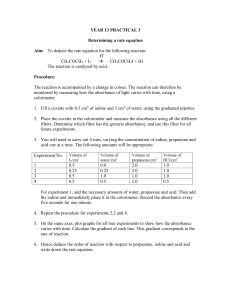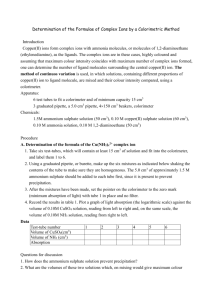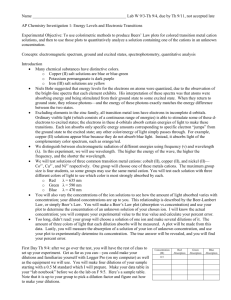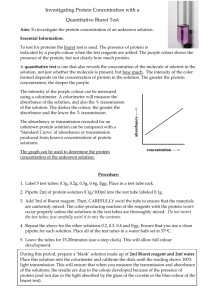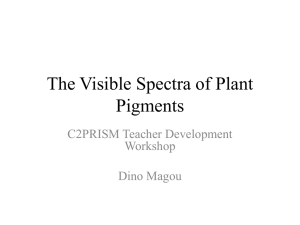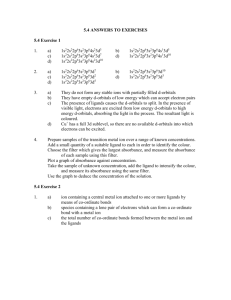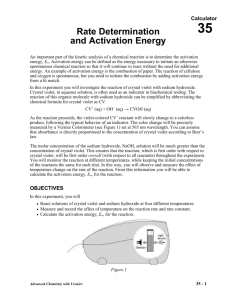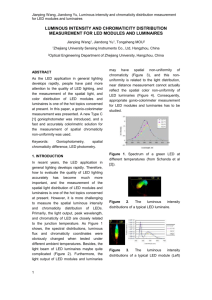To determine the formula of a complex ion by using colorimeter
advertisement
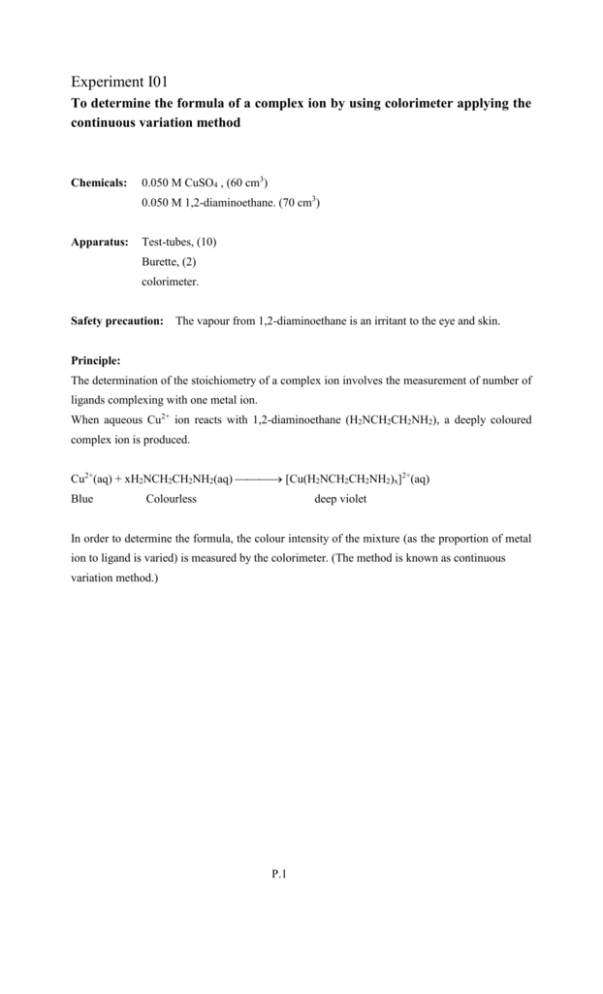
Experiment I01 To determine the formula of a complex ion by using colorimeter applying the continuous variation method Chemicals: 0.050 M CuSO4 , (60 cm3) 0.050 M 1,2-diaminoethane. (70 cm3) Apparatus: Test-tubes, (10) Burette, (2) colorimeter. Safety precaution: The vapour from 1,2-diaminoethane is an irritant to the eye and skin. Principle: The determination of the stoichiometry of a complex ion involves the measurement of number of ligands complexing with one metal ion. When aqueous Cu2+ ion reacts with 1,2-diaminoethane (H2NCH2CH2NH2), a deeply coloured complex ion is produced. Cu2+(aq) + xH2NCH2CH2NH2(aq) [Cu(H2NCH2CH2NH2)x]2+(aq) Blue Colourless deep violet In order to determine the formula, the colour intensity of the mixture (as the proportion of metal ion to ligand is varied) is measured by the colorimeter. (The method is known as continuous variation method.) P.1 Experiment I01 To determine the formula of a complex ion by using colorimeter applying the continuous variation method Principle of a colorimenter: The current generated in the photocell is proportional to the amount of light transmitted by the solution, which in turn depends on the concentration (the colour) of the complex. Selecting a suitable filter According to the colour of the solution, the filter used should be one of the complementary. (?) Colour of the solution Suitable filter Green red Blue-green orange Blue yellow Violet yellow-green P.2 Experiment I01 To determine the formula of a complex ion by using colorimeter applying the continuous variation method Procedure: a. Take ten test-tubes and number them 1 to 10. Using these test-tubes, make up the mixtures of 0.050 M CuSO4 and 0.050 M 1,2-diaminoethane with the compositions shown below. Shake each tube to ensure that the solutions are thoroughly mixed. Test-tube number 1 2 3 Vol. of 0.05 M CuSO4/cm3 0.0 2.0 3.0 Vol. of 0.05 M 1,2-diaminoethane/cm3 12.0 10.0 9.0 4 5 6 7 8 9 10 4.0 6.0 7.0 8.0 9.0 10.0 12.0 8.0 6.0 5.0 4.0 3.0 2.0 0.0 b. Before you carry on, choose the most suitable filter (yellow-green) for the experiment. c. Insert the filter. Switch on the power and allow five minutes for the instrument to warm up. d. Obtain zero absorbance with tube 1, containing only 1,2-diaminoethane solution is placed in the colorimeter. Now measure the absorbance of the other mixtures relative to this zero reading. P.3 Experiment I01 To determine the formula of a complex ion by using colorimeter applying the continuous variation method Name: Seat No.: Date: Result Test-tube number Absorbance Grade: 1 2 3 4 5 6 7 8 9 10 0.00 Questions: 1. Plot a graph of absorbance against the volume of 0.050M CuSO4 reading from left to right, and on the same horizontal scale, the volume of 0.050M 1,2-diaminoethane solution reading from right to left. 2. What are the volumes of the two solutions which on mixing, give the maximum colour intensity? 3. Draw the complex ion. P.4 Experiment I01 To determine the formula of a complex ion by using colorimeter applying the continuous variation method 4. What are the colours of Cu2+(aq) and 1,2-diaminoethane solution? 5. What is the colour of the complex formed from Cu2+ and 1,2-diaminoethane? 6. What is the colour of the filter which would be most suitable for the experiment? 7. In what molar proportions do Cu2+ and H2NCH2CH2NH2 react to form the complex? 8. Write an equation for the formation of the complex. P.5

